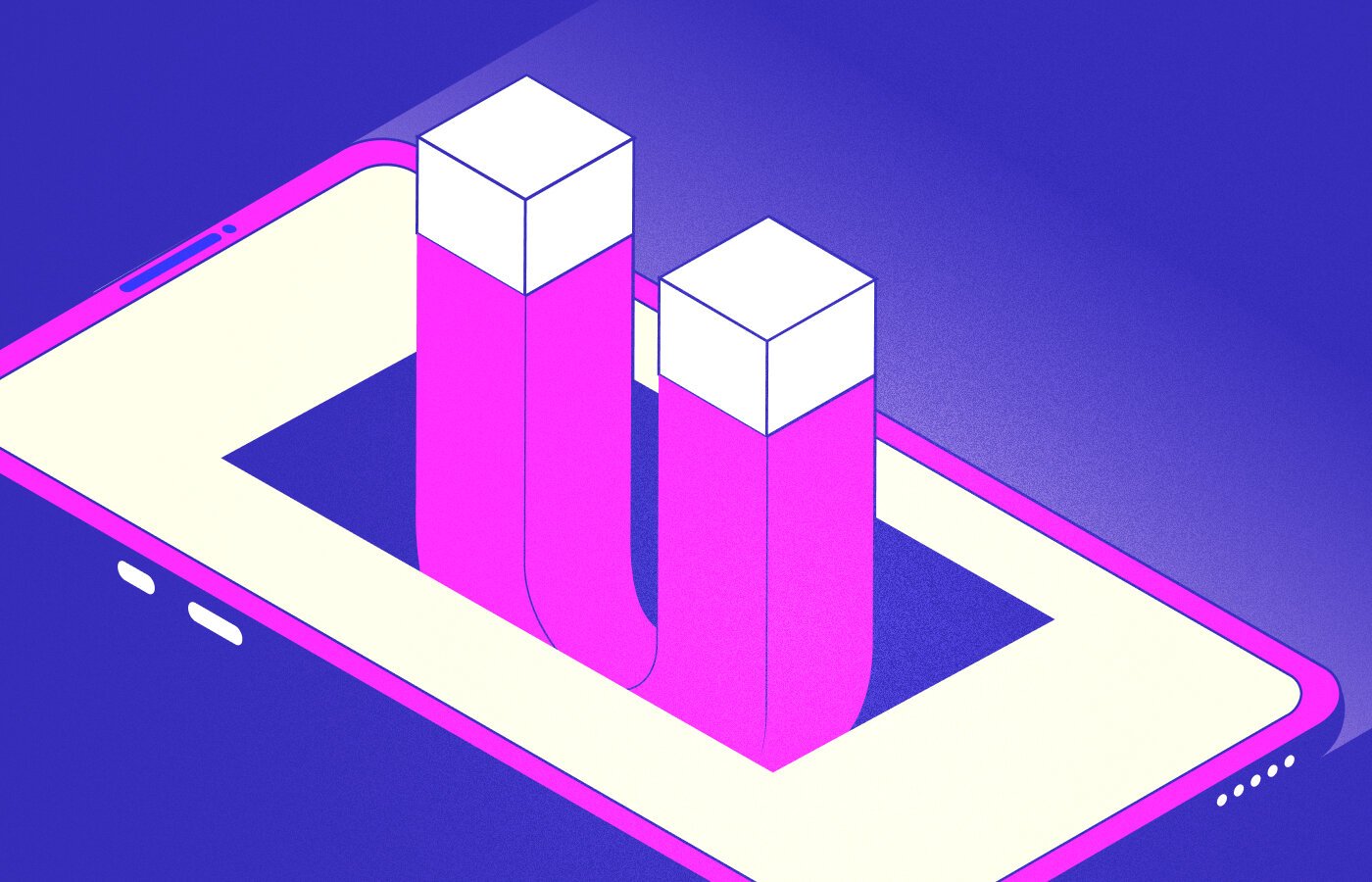blog
The Role of Mobile Applications in Customer Retention
By Mohan S App development Customer Experience October 6, 2023

The way that companies interact with their customers has been revolutionized by mobile apps, which present special opportunities to use customer retention tactics. When these tactics are successfully applied via customer facing apps, customer loyalty and satisfaction can greatly increase.
What is customer retention, and why is it important?
Customer retention is the ability of a company to retain its current customers over time. It is a crucial metric that assesses the proportion of clients who stick with a business over time. Customer retention differs from customer acquisition in that it focuses on nurturing and upholding relationships with current customers rather than bringing in new ones.
To underscore the significance of customer retention, here are some compelling statistics:
A 5% increase in customer retention can lead to a 25–95% increase in profits. (Harvard Business Review)
Boosting customer retention rates by just 5% can increase profits by between 25% and 95% (Deloitte)
Gaining a new customer is five times more expensive than retaining an existing one. (Invespcro)
Customer Retention Strategies Using Mobile Apps
Here is a look at how mobile apps can be used to implement personalized experience strategies:
1. Personalized Experiences
A key component of contemporary customer retention strategies is personalization. It entails customizing interactions, recommendations, and content to each customer's preferences and habits. Due to their capacity to gather and analyze user data, mobile apps excel at delivering personalized experiences that let businesses provide pertinent and interesting content.
Role of Mobile Apps:
User Data Collection: Mobile apps can gather valuable user data, including browsing history, purchase patterns, location data, and more. This data serves as the foundation for creating personalized experiences.
User Profiles: Apps can allow users to create profiles where they can input preferences, interests, and demographic information. This information forms the basis for delivering content that resonates with each individual.
Recommendations: Based on the collected data, mobile apps can provide tailored product recommendations and content suggestions. These recommendations can entice users to explore more of what interests them.
Behavioral Triggers: Mobile apps can trigger personalized messages or offers based on user actions, such as completing a purchase, abandoning a cart, or reaching a milestone.
In-App Messaging: Apps can use in-app messaging to deliver personalized updates, tips, and offers directly to users within the app interface.
Push Notifications: Push notifications can be customized to deliver personalized offers, reminders, and updates. These notifications can re-engage users even when the app is not open.
Location-Based Personalization: Using location data, apps can provide information about nearby stores, events, or promotions, adding a layer of context to the user's experience.
Tailored Content: Apps can offer content based on user interests, such as articles, videos, or tutorials that align with their preferences.
Benefits of Personalized Experiences via Mobile Apps:
Enhanced Engagement: Personalized experiences capture users' attention, leading to increased engagement with the app and its content.
Improved Customer Satisfaction: When users receive content and offers aligned with their interests, they are more likely to feel satisfied and valued by the brand.
Higher Conversion Rates: Personalized product recommendations and offers can drive higher conversion rates as they cater to users' specific needs.
Stronger Brand Loyalty: A personalized experience demonstrates a brand's commitment to understanding and meeting individual customer preferences, fostering loyalty.
Decreased Churn: Tailored interactions make customers less likely to abandon the app in favor of competitors.
Customers and your brand may feel a stronger emotional connection if personalized mobile app experiences are included. This tactic is an effective way to show that you value each customer's particular preferences and make a positive contribution to the customer experience, which will ultimately increase customer retention.
2. Implement loyalty programs
Customers who consistently interact with, buy from, and engage with a brand are rewarded through loyalty programs. These programs promote customer retention by providing rewards that encourage repeat usage. A seamless and engaging experience for customers is provided by mobile apps, which provide an ideal platform for hosting and managing loyalty programs.
Role of Mobile Apps:
Enrollment and Tracking: Mobile apps enable customers to easily enroll in loyalty programs and keep track of their rewards, points, and progress toward different tiers.
Digital Punch Cards: Apps can replace traditional physical punch cards with digital versions, allowing customers to collect rewards for repeat visits or purchases.
Tiered Rewards: Loyalty programs often include different tiers based on customer activity. Mobile apps can showcase the benefits and rewards associated with each tier, motivating users to achieve higher levels.
Personalized Offers: Apps collect user data that can be used to personalize loyalty rewards and offers, ensuring that customers receive incentives that match their preferences and behavior.
Push Notifications: Mobile apps can send push notifications to alert users about special loyalty offers, promotions, or when they're close to unlocking a new reward.
Gamification: Apps can introduce gamified elements to loyalty programs, adding an element of fun and competition. This might involve challenges, badges, or exclusive rewards for completing certain actions.
Benefits of Implementing Loyalty Programs via Mobile Apps:
Increased Customer Engagement: Loyalty programs incentivize users to interact with the app more frequently, boosting engagement and app usage.
Repeat Purchases: The prospect of earning rewards encourages customers to make repeat purchases, increasing their lifetime value.
Enhanced Brand Loyalty: Customers feel valued when they are rewarded for their loyalty, fostering a stronger emotional connection to the brand.
Data Collection: Loyalty programs allow businesses to collect valuable data on customer preferences and behavior, informing further personalization efforts.
Word-of-Mouth Promotion: Satisfied loyalty program members are more likely to recommend the brand and its app to others, aiding in new customer acquisition.
Competitive Advantage: A well-designed loyalty program on a mobile app can differentiate your brand from competitors and attract new customers.
Utilizing mobile apps to implement loyalty programs has the potential to significantly increase customer retention rates. Businesses can encourage repeat engagement, drive customer loyalty, and create a positive feedback loop where devoted customers act as brand ambassadors by providing concrete rewards and personalized incentives.
3. Push notification updates for new features and offers
Even when an app is not actively being used, push notifications are direct messages that are sent to a user's mobile device. In order to keep users engaged and interested in the app, this strategy uses push notifications to let them know about new features, updates, promotions, and offers.
Role of Mobile Apps:
Announcing New Features: Mobile apps can use push notifications to alert users about new app features, enhancements, or improvements. This encourages users to explore and interact with the updated app.
Promoting Offers: Push notifications are an effective way to inform users about special offers, discounts, or limited-time promotions. This can drive users back to the app to make purchases.
Event Reminders: Apps can send notifications to remind users about upcoming events, sales, or releases, ensuring that users don't miss out on important dates.
Engagement Triggers: Notifications can be triggered based on user behavior, such as completing a purchase, adding items to the cart, or not visiting the app for a while.
Personalization: Push notifications can be personalized based on user preferences, previous interactions, and location, making them more relevant and appealing.
Segmentation: Mobile apps can segment users based on various factors (e.g., location, interests, purchase history) and send targeted notifications to specific groups.
Benefits of Push Notification Updates via Mobile Apps:
Re-Engagement: Push notifications act as gentle reminders, enticing users to open the app and explore new features or offers.
Timely Communication: Important updates or offers can be instantly communicated to users, ensuring they are informed without delay.
Increased Conversion: Push notifications about special offers can lead to increased conversion rates as users are prompted to take action.
App Habit Formation: Regular notifications can help form a habit of app usage, making users more likely to engage with the app consistently.
Enhanced User Experience: By notifying users about new features, apps can provide an improved and more user-centric experience.
Direct Communication: Push notifications offer a direct channel of communication, bypassing email or social media, which might not always reach users promptly.
When using push notifications effectively, it's important to strike a careful balance between giving users useful information and preventing notification overload. Push notifications can be a strong tool to keep users interested, informed, and enthusiastic about using your mobile app when implemented carefully, which will ultimately lead to higher customer retention rates.
4. Fast Customer Support and complaint resolution
Excellent customer service is essential for preserving client satisfaction and loyalty. A positive user experience can be achieved by quickly responding to customer questions, issues, and complaints through mobile apps.
Role of Mobile Apps:
In-App Chat: Mobile apps can integrate chat features that allow users to initiate real-time conversations with customer support representatives directly within the app.
Ticket Submission: Apps can provide a feature where users can submit support tickets with details about their issues or inquiries. This ensures that their concerns are documented and addressed.
FAQs and Knowledge Base: Mobile apps can include a section with frequently asked questions and a knowledge base that helps users find answers to common queries on their own.
Push Notifications for Responses: When a customer support representative responds to a user's inquiry or complaint, apps can send push notifications to inform the user about the response.
Automated Responses: For common questions, apps can implement automated responses that provide immediate assistance while users wait for a more detailed response from a representative.
Benefits of Fast Customer Support via Mobile Apps:
Higher Customer Satisfaction: Prompt responses and efficient complaint resolution lead to happier customers who feel valued by the brand.
Reduced Frustration: Quick assistance minimizes the frustration that can arise from waiting for support and dealing with issues.
Brand Trust: A commitment to fast customer support builds trust and enhances the brand's reputation for reliability.
Enhanced Retention: Customers who experience efficient support are more likely to remain loyal and continue using the app.
Positive Word-of-Mouth: Satisfied customers are more likely to share positive experiences with others, driving potential new users to the app.
Problem Resolution: Fast support helps address problems early, preventing potential escalations and negative impacts on user experience.
Mobile apps can create a positive user experience that fosters brand loyalty and motivates users to keep using the app by offering quick customer support and efficient complaint resolution. In the cutthroat business environment of today, where providing exceptional customer service sets businesses apart, this strategy is especially important.
5. Segmentation and Targeting
By using segmentation, you can separate your user base into various groups according to predetermined standards. This tactic aids in customizing your interactions, messages, and offers to the unique requirements and preferences of each segment. You can efficiently apply cohort analysis and segmentation through mobile apps to improve customer retention.
Role of Mobile Apps:
User Behavior Analysis: Mobile apps can track user behavior, including engagement patterns, purchase history, and preferences. This data forms the basis for creating segments.
Segment Definition: By categorizing users into segments, such as frequent buyers, occasional users, or high spenders, apps can better understand their different needs.
Personalized Messaging: Apps use segmentation to send personalized messages, offers, and recommendations to each group, increasing the relevancy of communication.
A/B Testing: Apps can conduct A/B testing on different segments to determine which messages or offers are most effective for each group.
Cohort Analysis: Cohort analysis involves tracking groups of users who share common characteristics and behaviors over time. This helps identify trends and patterns in user engagement.
Benefits of Segmentation and Targeting via Mobile Apps:
Relevant Communication: Segmented messaging ensures that users receive information that aligns with their interests, leading to higher engagement.
Improved Conversion: Targeted offers and messages have a higher likelihood of resonating with users, leading to increased conversion rates.
Enhanced User Experience: Personalized interactions through segmentation contribute to an overall positive user experience, increasing customer satisfaction.
Efficient Resource Allocation: By focusing resources on the most receptive segments, apps can optimize their marketing efforts for better results.
Insightful Analytics: Cohort analysis provides valuable insights into user behavior over time, enabling better decision-making for retention strategies.
Mobile app segmentation and targeting enable businesses to customize their strategy for specific user segments, maximizing the impact of marketing initiatives and raising the likelihood that users will stick around. This tactic emphasizes the significance of comprehending the diversity of your user base and addressing their unique needs and preferences.
6. Simplify Onboarding and Navigation
Retaining users is greatly influenced by the onboarding procedure and the simplicity of the mobile app's navigation. Users may give up using the app quickly if they find it difficult to understand and navigate. Therefore, for customers to stay with you, it's crucial to streamline the onboarding procedure and make navigation simple.
Role of Mobile Apps:
Guided Onboarding: Apps can provide step-by-step guidance during the onboarding process, helping users understand key features and functionalities.
Minimalist Design: A clean and minimalist design reduces clutter, making it easier for users to navigate and find what they need.
Clear Call to Action: Mobile apps should have clear and prominent call-to-action buttons that guide users toward desired actions.
Intuitive Navigation: Apps should have a straightforward and logical navigation structure, making it easy for users to move between sections.
Interactive Tutorials: Interactive tutorials or tooltips can guide users through the app's features, encouraging them to explore and engage.
User Feedback: Apps can incorporate feedback mechanisms to understand where users are facing difficulties and make necessary improvements.
Benefits of Simplified Onboarding and Navigation via Mobile Apps:
Positive First Impressions: A smooth onboarding process and intuitive navigation create a positive initial experience, setting the tone for continued app usage.
Reduced Abandonment: Users are less likely to abandon an app due to confusion or frustration when onboarding and navigation are straightforward.
Higher Engagement: Intuitive navigation encourages users to explore various app features, leading to higher engagement rates.
Faster Learning Curve: Simplified onboarding helps users quickly grasp the app's value and functionalities, reducing the learning curve.
Enhanced User Satisfaction: Easy-to-use apps contribute to user satisfaction and increase the likelihood of users returning.
Lower Support Requests: Intuitive design and clear navigation can reduce the need for users to seek customer support for basic inquiries.
Mobile apps can guarantee that users have a positive experience right away by giving priority to a seamless onboarding process and simple navigation. In addition to encouraging users to stay, this lays the groundwork for ongoing engagement and long-term client retention.
7. Implement effective feedback loops
To enhance the app and overall user experience, feedback loops actively seek out and incorporate user feedback. You can increase customer retention by listening to user suggestions, responding to their concerns, and continually improving the app based on their feedback.
Role of Mobile Apps:
In-App Feedback Channels: Apps can integrate dedicated feedback forms that users can easily access within the app interface.
Surveys and Polls: Mobile apps can use surveys and polls to gather insights from users about their preferences, pain points, and suggestions.
Rating and Review Prompts: Apps can prompt users to rate and review the app, allowing them to share their opinions and experiences.
User-Initiated Feedback: Provide a way for users to offer feedback directly from the app, making it easy for them to voice their thoughts.
Responsive Support: Respond to user feedback promptly and show that their input is valued.
Benefits of Implementing Effective Feedback Loops via Mobile Apps:
User-Centric Improvements: Actively listening to feedback leads to app enhancements that align with users' needs and preferences.
Enhanced Engagement: Users are more likely to engage with an app that demonstrates responsiveness to their feedback.
User Empowerment: When users see their suggestions being implemented, they feel a sense of ownership and are more likely to stay engaged.
Trust Building: A willingness to listen to feedback builds trust and shows that the app is committed to continuous improvement.
Insight into Pain Points: Feedback offers insights into pain points and issues users encounter, allowing for targeted improvements.
Feature Prioritization: Feedback helps prioritize which features or improvements are most important to users.
Mobile apps can maintain a constant dialogue with users thanks to efficient feedback loops, which foster a sense of community and show a commitment to providing the best user experience. By including users in the development of the app, you can increase retention while also building a devoted user base that feels appreciated and understood.
Conclusion
Customer retention is a critical component of business success, and mobile apps provide a strong platform for putting into practice powerful strategies that keep customers engaged, satisfied, and loyal.
Mobile apps are now a necessity for companies looking to increase customer retention in the cutthroat business environment of today. Each tactic covered here contributes to a comprehensive strategy that fosters customer loyalty, turns customers into brand evangelists, and promotes long-term business growth in addition to user retention.
Businesses can build a user-centric ecosystem that values unique preferences, engages users at every touchpoint, and fosters a sense of belonging by seamlessly integrating these strategies into mobile apps. This will ultimately result in a higher customer retention rate and long-term success.




